Leadership for Managers: Theories, Styles, and Importance
VerifiedAdded on 2023/06/07
|13
|3479
|432
AI Summary
This article discusses the different leadership theories, styles, and their importance in managing teams and organizations. It covers the transformational and adaptive leadership theories, democratic leadership, and other leadership styles. It also emphasizes the importance of leadership qualities for managers and the application of different leadership approaches depending on the circumstances and tasks ahead. The article concludes by recommending the use of multiple management styles amongst leaders as the most effective approach in management.
Contribute Materials
Your contribution can guide someone’s learning journey. Share your
documents today.
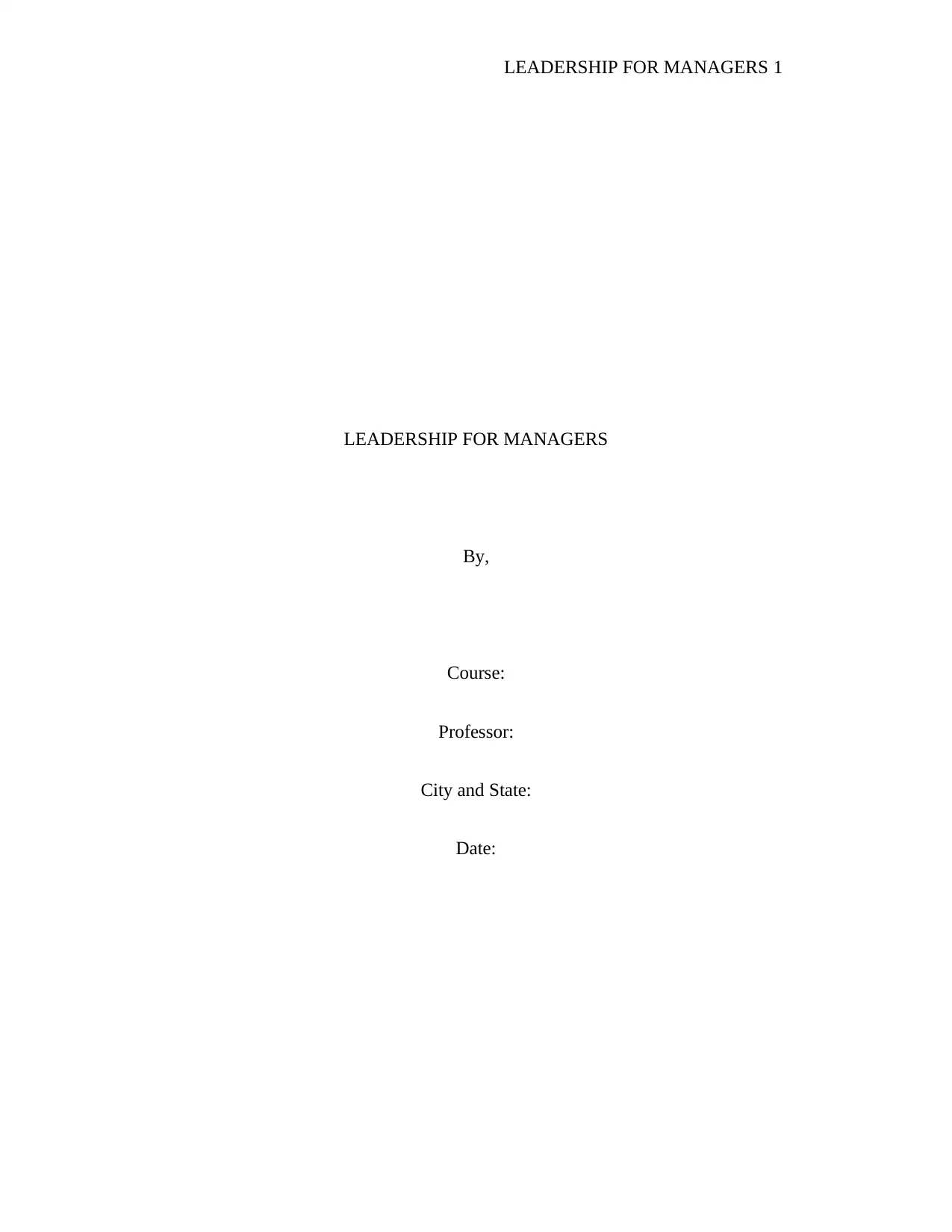
LEADERSHIP FOR MANAGERS 1
LEADERSHIP FOR MANAGERS
By,
Course:
Professor:
City and State:
Date:
LEADERSHIP FOR MANAGERS
By,
Course:
Professor:
City and State:
Date:
Secure Best Marks with AI Grader
Need help grading? Try our AI Grader for instant feedback on your assignments.
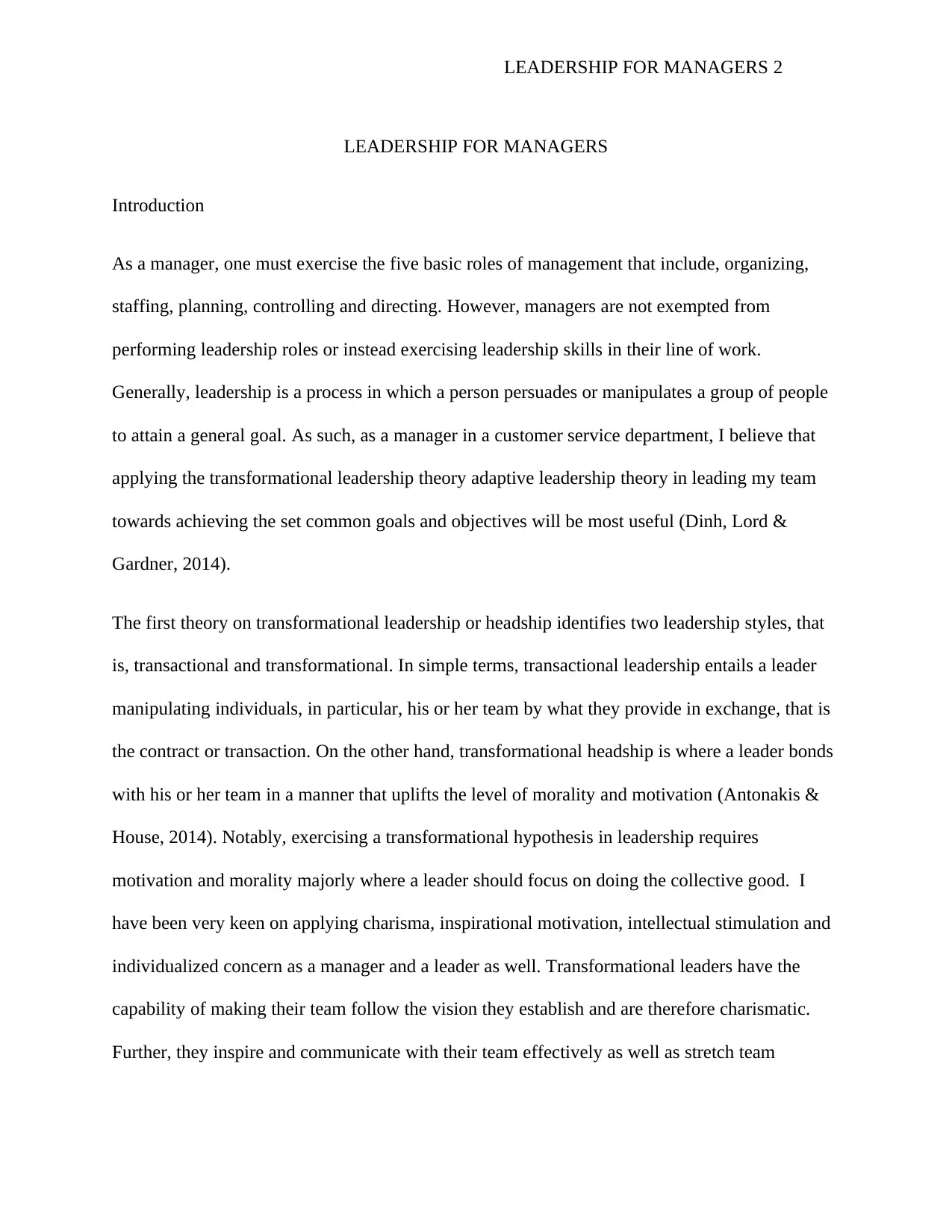
LEADERSHIP FOR MANAGERS 2
LEADERSHIP FOR MANAGERS
Introduction
As a manager, one must exercise the five basic roles of management that include, organizing,
staffing, planning, controlling and directing. However, managers are not exempted from
performing leadership roles or instead exercising leadership skills in their line of work.
Generally, leadership is a process in which a person persuades or manipulates a group of people
to attain a general goal. As such, as a manager in a customer service department, I believe that
applying the transformational leadership theory adaptive leadership theory in leading my team
towards achieving the set common goals and objectives will be most useful (Dinh, Lord &
Gardner, 2014).
The first theory on transformational leadership or headship identifies two leadership styles, that
is, transactional and transformational. In simple terms, transactional leadership entails a leader
manipulating individuals, in particular, his or her team by what they provide in exchange, that is
the contract or transaction. On the other hand, transformational headship is where a leader bonds
with his or her team in a manner that uplifts the level of morality and motivation (Antonakis &
House, 2014). Notably, exercising a transformational hypothesis in leadership requires
motivation and morality majorly where a leader should focus on doing the collective good. I
have been very keen on applying charisma, inspirational motivation, intellectual stimulation and
individualized concern as a manager and a leader as well. Transformational leaders have the
capability of making their team follow the vision they establish and are therefore charismatic.
Further, they inspire and communicate with their team effectively as well as stretch team
LEADERSHIP FOR MANAGERS
Introduction
As a manager, one must exercise the five basic roles of management that include, organizing,
staffing, planning, controlling and directing. However, managers are not exempted from
performing leadership roles or instead exercising leadership skills in their line of work.
Generally, leadership is a process in which a person persuades or manipulates a group of people
to attain a general goal. As such, as a manager in a customer service department, I believe that
applying the transformational leadership theory adaptive leadership theory in leading my team
towards achieving the set common goals and objectives will be most useful (Dinh, Lord &
Gardner, 2014).
The first theory on transformational leadership or headship identifies two leadership styles, that
is, transactional and transformational. In simple terms, transactional leadership entails a leader
manipulating individuals, in particular, his or her team by what they provide in exchange, that is
the contract or transaction. On the other hand, transformational headship is where a leader bonds
with his or her team in a manner that uplifts the level of morality and motivation (Antonakis &
House, 2014). Notably, exercising a transformational hypothesis in leadership requires
motivation and morality majorly where a leader should focus on doing the collective good. I
have been very keen on applying charisma, inspirational motivation, intellectual stimulation and
individualized concern as a manager and a leader as well. Transformational leaders have the
capability of making their team follow the vision they establish and are therefore charismatic.
Further, they inspire and communicate with their team effectively as well as stretch team
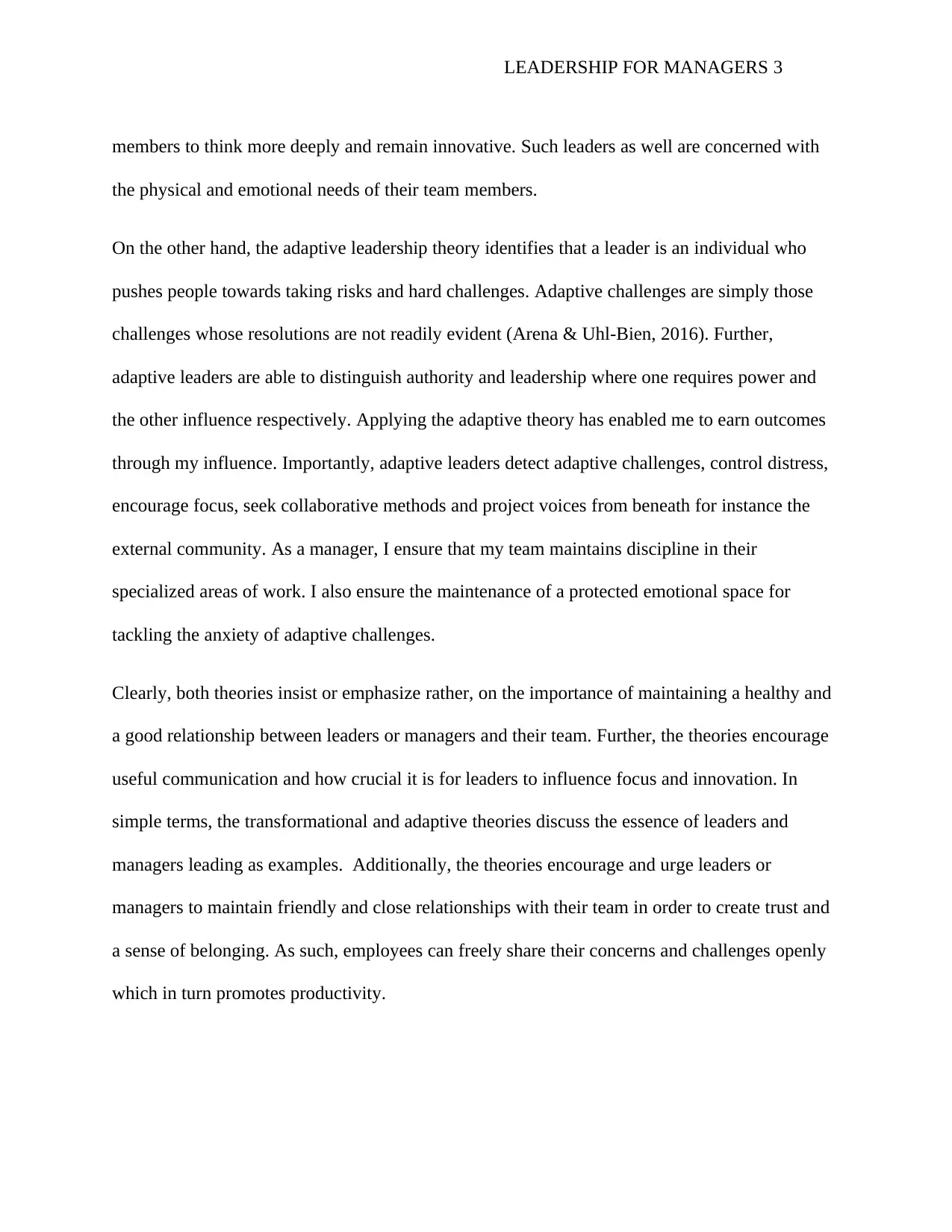
LEADERSHIP FOR MANAGERS 3
members to think more deeply and remain innovative. Such leaders as well are concerned with
the physical and emotional needs of their team members.
On the other hand, the adaptive leadership theory identifies that a leader is an individual who
pushes people towards taking risks and hard challenges. Adaptive challenges are simply those
challenges whose resolutions are not readily evident (Arena & Uhl-Bien, 2016). Further,
adaptive leaders are able to distinguish authority and leadership where one requires power and
the other influence respectively. Applying the adaptive theory has enabled me to earn outcomes
through my influence. Importantly, adaptive leaders detect adaptive challenges, control distress,
encourage focus, seek collaborative methods and project voices from beneath for instance the
external community. As a manager, I ensure that my team maintains discipline in their
specialized areas of work. I also ensure the maintenance of a protected emotional space for
tackling the anxiety of adaptive challenges.
Clearly, both theories insist or emphasize rather, on the importance of maintaining a healthy and
a good relationship between leaders or managers and their team. Further, the theories encourage
useful communication and how crucial it is for leaders to influence focus and innovation. In
simple terms, the transformational and adaptive theories discuss the essence of leaders and
managers leading as examples. Additionally, the theories encourage and urge leaders or
managers to maintain friendly and close relationships with their team in order to create trust and
a sense of belonging. As such, employees can freely share their concerns and challenges openly
which in turn promotes productivity.
members to think more deeply and remain innovative. Such leaders as well are concerned with
the physical and emotional needs of their team members.
On the other hand, the adaptive leadership theory identifies that a leader is an individual who
pushes people towards taking risks and hard challenges. Adaptive challenges are simply those
challenges whose resolutions are not readily evident (Arena & Uhl-Bien, 2016). Further,
adaptive leaders are able to distinguish authority and leadership where one requires power and
the other influence respectively. Applying the adaptive theory has enabled me to earn outcomes
through my influence. Importantly, adaptive leaders detect adaptive challenges, control distress,
encourage focus, seek collaborative methods and project voices from beneath for instance the
external community. As a manager, I ensure that my team maintains discipline in their
specialized areas of work. I also ensure the maintenance of a protected emotional space for
tackling the anxiety of adaptive challenges.
Clearly, both theories insist or emphasize rather, on the importance of maintaining a healthy and
a good relationship between leaders or managers and their team. Further, the theories encourage
useful communication and how crucial it is for leaders to influence focus and innovation. In
simple terms, the transformational and adaptive theories discuss the essence of leaders and
managers leading as examples. Additionally, the theories encourage and urge leaders or
managers to maintain friendly and close relationships with their team in order to create trust and
a sense of belonging. As such, employees can freely share their concerns and challenges openly
which in turn promotes productivity.
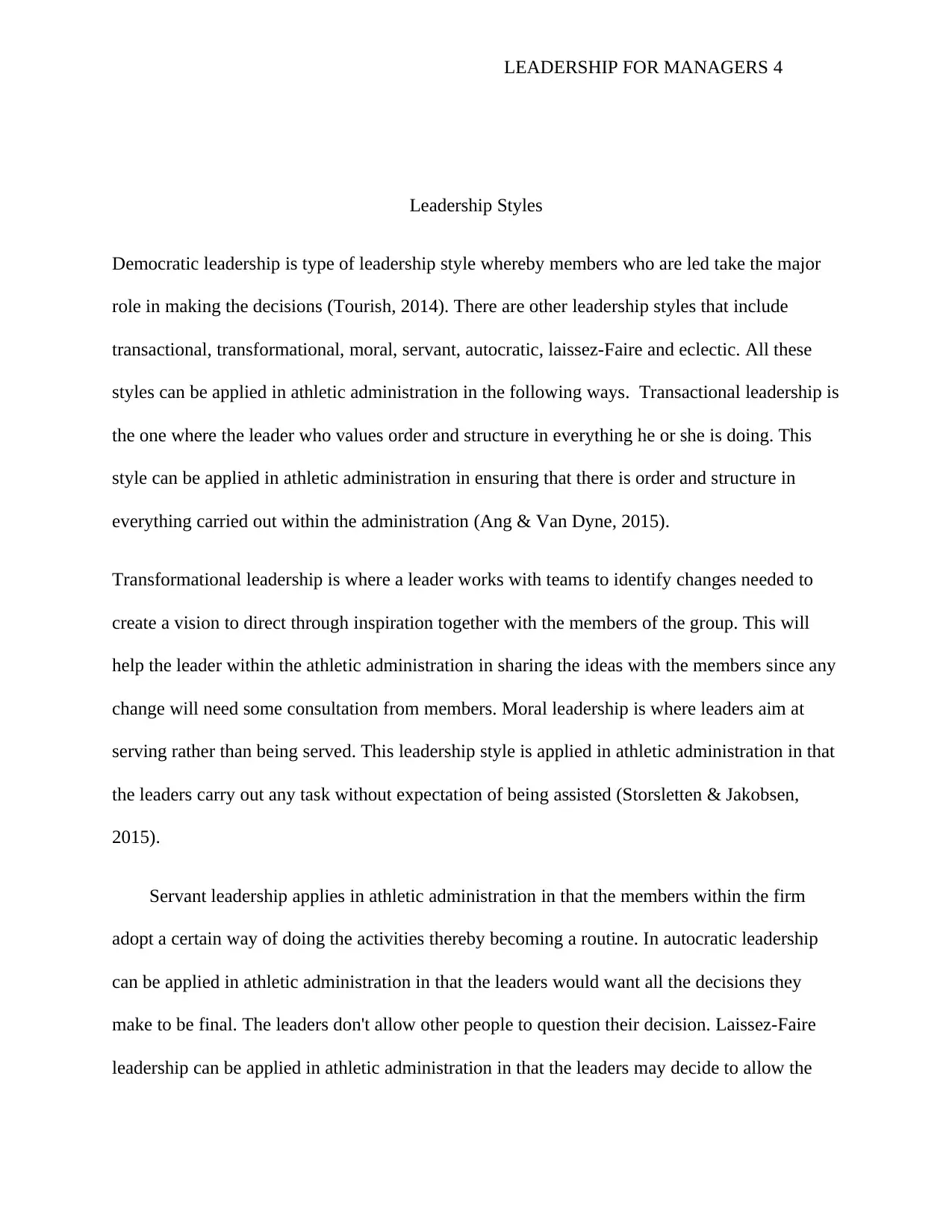
LEADERSHIP FOR MANAGERS 4
Leadership Styles
Democratic leadership is type of leadership style whereby members who are led take the major
role in making the decisions (Tourish, 2014). There are other leadership styles that include
transactional, transformational, moral, servant, autocratic, laissez-Faire and eclectic. All these
styles can be applied in athletic administration in the following ways. Transactional leadership is
the one where the leader who values order and structure in everything he or she is doing. This
style can be applied in athletic administration in ensuring that there is order and structure in
everything carried out within the administration (Ang & Van Dyne, 2015).
Transformational leadership is where a leader works with teams to identify changes needed to
create a vision to direct through inspiration together with the members of the group. This will
help the leader within the athletic administration in sharing the ideas with the members since any
change will need some consultation from members. Moral leadership is where leaders aim at
serving rather than being served. This leadership style is applied in athletic administration in that
the leaders carry out any task without expectation of being assisted (Storsletten & Jakobsen,
2015).
Servant leadership applies in athletic administration in that the members within the firm
adopt a certain way of doing the activities thereby becoming a routine. In autocratic leadership
can be applied in athletic administration in that the leaders would want all the decisions they
make to be final. The leaders don't allow other people to question their decision. Laissez-Faire
leadership can be applied in athletic administration in that the leaders may decide to allow the
Leadership Styles
Democratic leadership is type of leadership style whereby members who are led take the major
role in making the decisions (Tourish, 2014). There are other leadership styles that include
transactional, transformational, moral, servant, autocratic, laissez-Faire and eclectic. All these
styles can be applied in athletic administration in the following ways. Transactional leadership is
the one where the leader who values order and structure in everything he or she is doing. This
style can be applied in athletic administration in ensuring that there is order and structure in
everything carried out within the administration (Ang & Van Dyne, 2015).
Transformational leadership is where a leader works with teams to identify changes needed to
create a vision to direct through inspiration together with the members of the group. This will
help the leader within the athletic administration in sharing the ideas with the members since any
change will need some consultation from members. Moral leadership is where leaders aim at
serving rather than being served. This leadership style is applied in athletic administration in that
the leaders carry out any task without expectation of being assisted (Storsletten & Jakobsen,
2015).
Servant leadership applies in athletic administration in that the members within the firm
adopt a certain way of doing the activities thereby becoming a routine. In autocratic leadership
can be applied in athletic administration in that the leaders would want all the decisions they
make to be final. The leaders don't allow other people to question their decision. Laissez-Faire
leadership can be applied in athletic administration in that the leaders may decide to allow the
Secure Best Marks with AI Grader
Need help grading? Try our AI Grader for instant feedback on your assignments.
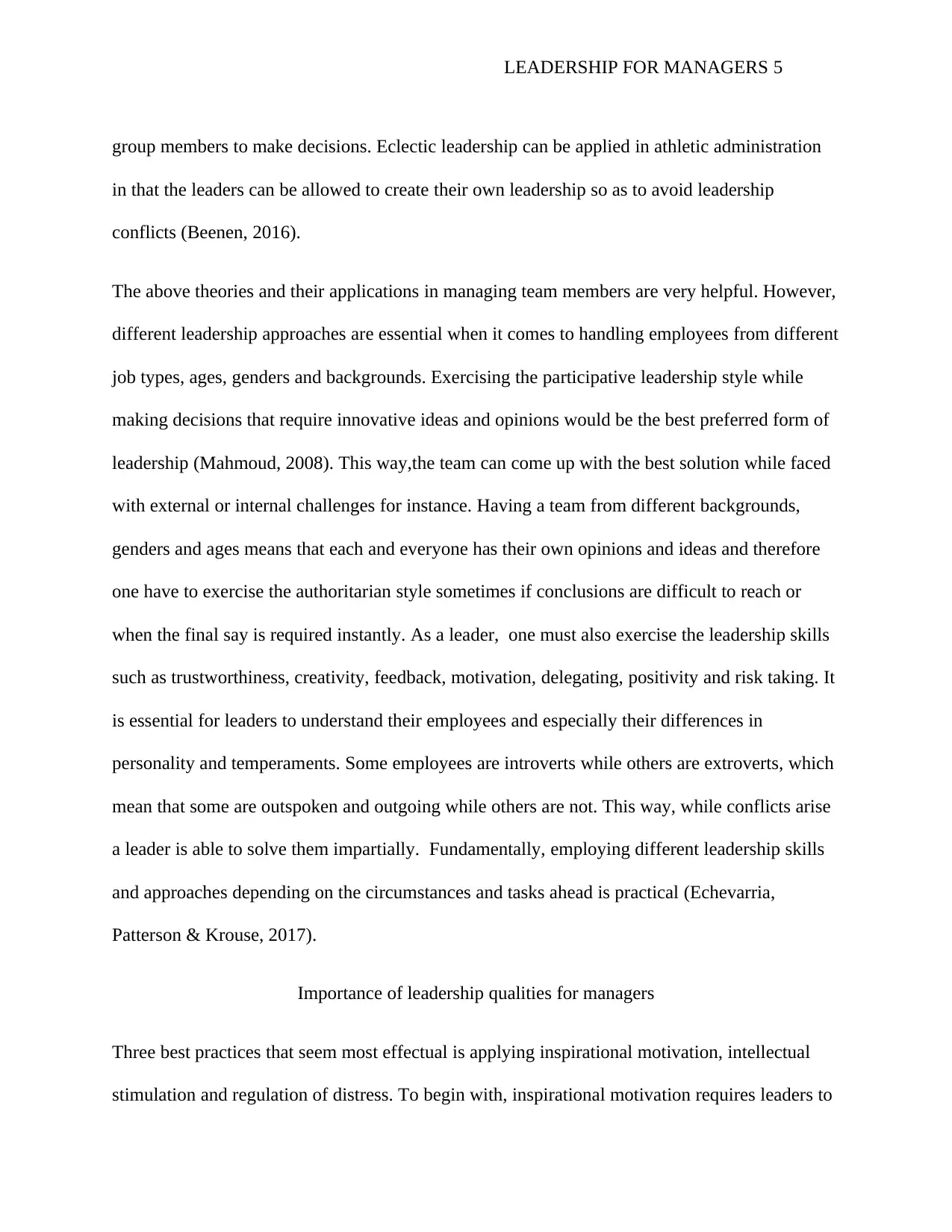
LEADERSHIP FOR MANAGERS 5
group members to make decisions. Eclectic leadership can be applied in athletic administration
in that the leaders can be allowed to create their own leadership so as to avoid leadership
conflicts (Beenen, 2016).
The above theories and their applications in managing team members are very helpful. However,
different leadership approaches are essential when it comes to handling employees from different
job types, ages, genders and backgrounds. Exercising the participative leadership style while
making decisions that require innovative ideas and opinions would be the best preferred form of
leadership (Mahmoud, 2008). This way,the team can come up with the best solution while faced
with external or internal challenges for instance. Having a team from different backgrounds,
genders and ages means that each and everyone has their own opinions and ideas and therefore
one have to exercise the authoritarian style sometimes if conclusions are difficult to reach or
when the final say is required instantly. As a leader, one must also exercise the leadership skills
such as trustworthiness, creativity, feedback, motivation, delegating, positivity and risk taking. It
is essential for leaders to understand their employees and especially their differences in
personality and temperaments. Some employees are introverts while others are extroverts, which
mean that some are outspoken and outgoing while others are not. This way, while conflicts arise
a leader is able to solve them impartially. Fundamentally, employing different leadership skills
and approaches depending on the circumstances and tasks ahead is practical (Echevarria,
Patterson & Krouse, 2017).
Importance of leadership qualities for managers
Three best practices that seem most effectual is applying inspirational motivation, intellectual
stimulation and regulation of distress. To begin with, inspirational motivation requires leaders to
group members to make decisions. Eclectic leadership can be applied in athletic administration
in that the leaders can be allowed to create their own leadership so as to avoid leadership
conflicts (Beenen, 2016).
The above theories and their applications in managing team members are very helpful. However,
different leadership approaches are essential when it comes to handling employees from different
job types, ages, genders and backgrounds. Exercising the participative leadership style while
making decisions that require innovative ideas and opinions would be the best preferred form of
leadership (Mahmoud, 2008). This way,the team can come up with the best solution while faced
with external or internal challenges for instance. Having a team from different backgrounds,
genders and ages means that each and everyone has their own opinions and ideas and therefore
one have to exercise the authoritarian style sometimes if conclusions are difficult to reach or
when the final say is required instantly. As a leader, one must also exercise the leadership skills
such as trustworthiness, creativity, feedback, motivation, delegating, positivity and risk taking. It
is essential for leaders to understand their employees and especially their differences in
personality and temperaments. Some employees are introverts while others are extroverts, which
mean that some are outspoken and outgoing while others are not. This way, while conflicts arise
a leader is able to solve them impartially. Fundamentally, employing different leadership skills
and approaches depending on the circumstances and tasks ahead is practical (Echevarria,
Patterson & Krouse, 2017).
Importance of leadership qualities for managers
Three best practices that seem most effectual is applying inspirational motivation, intellectual
stimulation and regulation of distress. To begin with, inspirational motivation requires leaders to
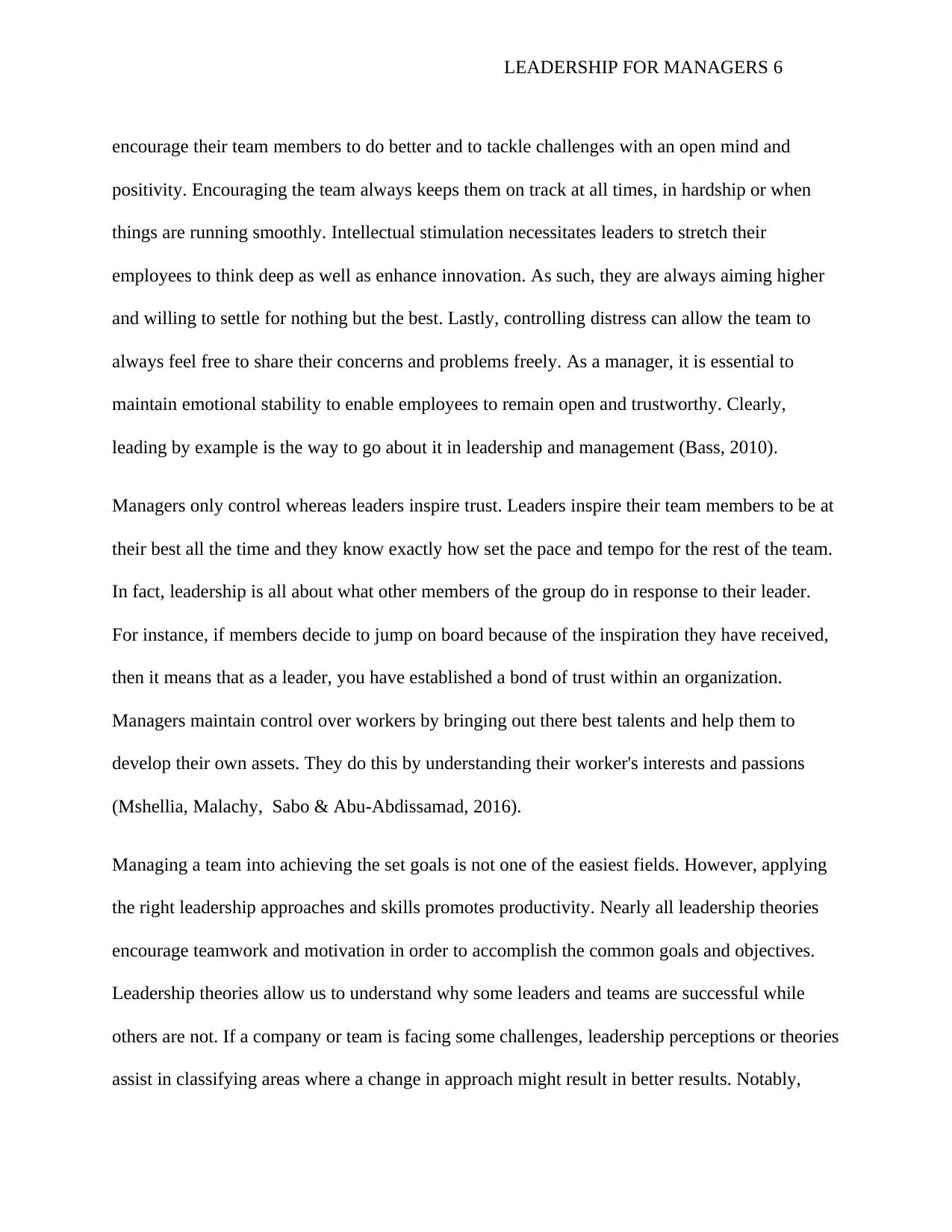
LEADERSHIP FOR MANAGERS 6
encourage their team members to do better and to tackle challenges with an open mind and
positivity. Encouraging the team always keeps them on track at all times, in hardship or when
things are running smoothly. Intellectual stimulation necessitates leaders to stretch their
employees to think deep as well as enhance innovation. As such, they are always aiming higher
and willing to settle for nothing but the best. Lastly, controlling distress can allow the team to
always feel free to share their concerns and problems freely. As a manager, it is essential to
maintain emotional stability to enable employees to remain open and trustworthy. Clearly,
leading by example is the way to go about it in leadership and management (Bass, 2010).
Managers only control whereas leaders inspire trust. Leaders inspire their team members to be at
their best all the time and they know exactly how set the pace and tempo for the rest of the team.
In fact, leadership is all about what other members of the group do in response to their leader.
For instance, if members decide to jump on board because of the inspiration they have received,
then it means that as a leader, you have established a bond of trust within an organization.
Managers maintain control over workers by bringing out there best talents and help them to
develop their own assets. They do this by understanding their worker's interests and passions
(Mshellia, Malachy, Sabo & Abu-Abdissamad, 2016).
Managing a team into achieving the set goals is not one of the easiest fields. However, applying
the right leadership approaches and skills promotes productivity. Nearly all leadership theories
encourage teamwork and motivation in order to accomplish the common goals and objectives.
Leadership theories allow us to understand why some leaders and teams are successful while
others are not. If a company or team is facing some challenges, leadership perceptions or theories
assist in classifying areas where a change in approach might result in better results. Notably,
encourage their team members to do better and to tackle challenges with an open mind and
positivity. Encouraging the team always keeps them on track at all times, in hardship or when
things are running smoothly. Intellectual stimulation necessitates leaders to stretch their
employees to think deep as well as enhance innovation. As such, they are always aiming higher
and willing to settle for nothing but the best. Lastly, controlling distress can allow the team to
always feel free to share their concerns and problems freely. As a manager, it is essential to
maintain emotional stability to enable employees to remain open and trustworthy. Clearly,
leading by example is the way to go about it in leadership and management (Bass, 2010).
Managers only control whereas leaders inspire trust. Leaders inspire their team members to be at
their best all the time and they know exactly how set the pace and tempo for the rest of the team.
In fact, leadership is all about what other members of the group do in response to their leader.
For instance, if members decide to jump on board because of the inspiration they have received,
then it means that as a leader, you have established a bond of trust within an organization.
Managers maintain control over workers by bringing out there best talents and help them to
develop their own assets. They do this by understanding their worker's interests and passions
(Mshellia, Malachy, Sabo & Abu-Abdissamad, 2016).
Managing a team into achieving the set goals is not one of the easiest fields. However, applying
the right leadership approaches and skills promotes productivity. Nearly all leadership theories
encourage teamwork and motivation in order to accomplish the common goals and objectives.
Leadership theories allow us to understand why some leaders and teams are successful while
others are not. If a company or team is facing some challenges, leadership perceptions or theories
assist in classifying areas where a change in approach might result in better results. Notably,
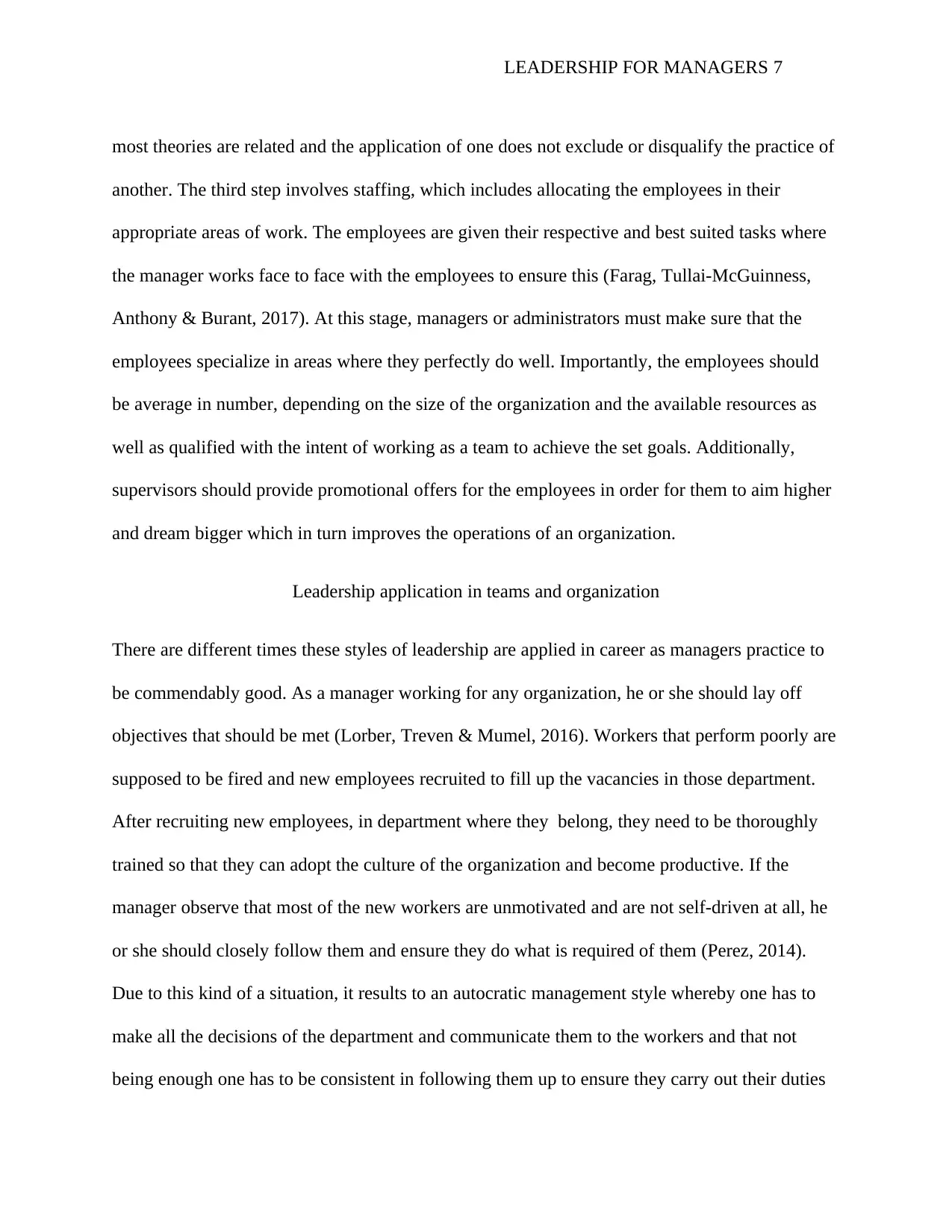
LEADERSHIP FOR MANAGERS 7
most theories are related and the application of one does not exclude or disqualify the practice of
another. The third step involves staffing, which includes allocating the employees in their
appropriate areas of work. The employees are given their respective and best suited tasks where
the manager works face to face with the employees to ensure this (Farag, Tullai-McGuinness,
Anthony & Burant, 2017). At this stage, managers or administrators must make sure that the
employees specialize in areas where they perfectly do well. Importantly, the employees should
be average in number, depending on the size of the organization and the available resources as
well as qualified with the intent of working as a team to achieve the set goals. Additionally,
supervisors should provide promotional offers for the employees in order for them to aim higher
and dream bigger which in turn improves the operations of an organization.
Leadership application in teams and organization
There are different times these styles of leadership are applied in career as managers practice to
be commendably good. As a manager working for any organization, he or she should lay off
objectives that should be met (Lorber, Treven & Mumel, 2016). Workers that perform poorly are
supposed to be fired and new employees recruited to fill up the vacancies in those department.
After recruiting new employees, in department where they belong, they need to be thoroughly
trained so that they can adopt the culture of the organization and become productive. If the
manager observe that most of the new workers are unmotivated and are not self-driven at all, he
or she should closely follow them and ensure they do what is required of them (Perez, 2014).
Due to this kind of a situation, it results to an autocratic management style whereby one has to
make all the decisions of the department and communicate them to the workers and that not
being enough one has to be consistent in following them up to ensure they carry out their duties
most theories are related and the application of one does not exclude or disqualify the practice of
another. The third step involves staffing, which includes allocating the employees in their
appropriate areas of work. The employees are given their respective and best suited tasks where
the manager works face to face with the employees to ensure this (Farag, Tullai-McGuinness,
Anthony & Burant, 2017). At this stage, managers or administrators must make sure that the
employees specialize in areas where they perfectly do well. Importantly, the employees should
be average in number, depending on the size of the organization and the available resources as
well as qualified with the intent of working as a team to achieve the set goals. Additionally,
supervisors should provide promotional offers for the employees in order for them to aim higher
and dream bigger which in turn improves the operations of an organization.
Leadership application in teams and organization
There are different times these styles of leadership are applied in career as managers practice to
be commendably good. As a manager working for any organization, he or she should lay off
objectives that should be met (Lorber, Treven & Mumel, 2016). Workers that perform poorly are
supposed to be fired and new employees recruited to fill up the vacancies in those department.
After recruiting new employees, in department where they belong, they need to be thoroughly
trained so that they can adopt the culture of the organization and become productive. If the
manager observe that most of the new workers are unmotivated and are not self-driven at all, he
or she should closely follow them and ensure they do what is required of them (Perez, 2014).
Due to this kind of a situation, it results to an autocratic management style whereby one has to
make all the decisions of the department and communicate them to the workers and that not
being enough one has to be consistent in following them up to ensure they carry out their duties
Paraphrase This Document
Need a fresh take? Get an instant paraphrase of this document with our AI Paraphraser
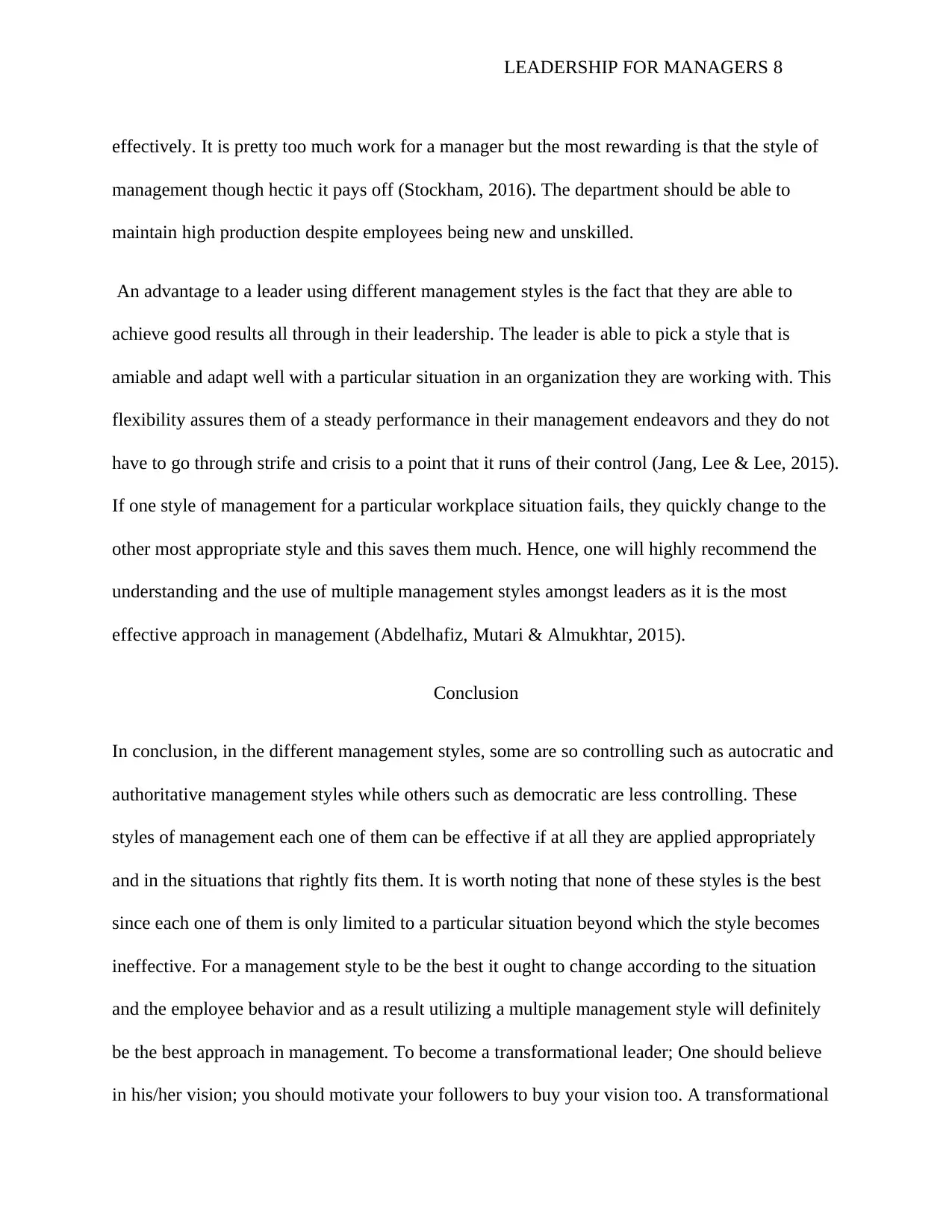
LEADERSHIP FOR MANAGERS 8
effectively. It is pretty too much work for a manager but the most rewarding is that the style of
management though hectic it pays off (Stockham, 2016). The department should be able to
maintain high production despite employees being new and unskilled.
An advantage to a leader using different management styles is the fact that they are able to
achieve good results all through in their leadership. The leader is able to pick a style that is
amiable and adapt well with a particular situation in an organization they are working with. This
flexibility assures them of a steady performance in their management endeavors and they do not
have to go through strife and crisis to a point that it runs of their control (Jang, Lee & Lee, 2015).
If one style of management for a particular workplace situation fails, they quickly change to the
other most appropriate style and this saves them much. Hence, one will highly recommend the
understanding and the use of multiple management styles amongst leaders as it is the most
effective approach in management (Abdelhafiz, Mutari & Almukhtar, 2015).
Conclusion
In conclusion, in the different management styles, some are so controlling such as autocratic and
authoritative management styles while others such as democratic are less controlling. These
styles of management each one of them can be effective if at all they are applied appropriately
and in the situations that rightly fits them. It is worth noting that none of these styles is the best
since each one of them is only limited to a particular situation beyond which the style becomes
ineffective. For a management style to be the best it ought to change according to the situation
and the employee behavior and as a result utilizing a multiple management style will definitely
be the best approach in management. To become a transformational leader; One should believe
in his/her vision; you should motivate your followers to buy your vision too. A transformational
effectively. It is pretty too much work for a manager but the most rewarding is that the style of
management though hectic it pays off (Stockham, 2016). The department should be able to
maintain high production despite employees being new and unskilled.
An advantage to a leader using different management styles is the fact that they are able to
achieve good results all through in their leadership. The leader is able to pick a style that is
amiable and adapt well with a particular situation in an organization they are working with. This
flexibility assures them of a steady performance in their management endeavors and they do not
have to go through strife and crisis to a point that it runs of their control (Jang, Lee & Lee, 2015).
If one style of management for a particular workplace situation fails, they quickly change to the
other most appropriate style and this saves them much. Hence, one will highly recommend the
understanding and the use of multiple management styles amongst leaders as it is the most
effective approach in management (Abdelhafiz, Mutari & Almukhtar, 2015).
Conclusion
In conclusion, in the different management styles, some are so controlling such as autocratic and
authoritative management styles while others such as democratic are less controlling. These
styles of management each one of them can be effective if at all they are applied appropriately
and in the situations that rightly fits them. It is worth noting that none of these styles is the best
since each one of them is only limited to a particular situation beyond which the style becomes
ineffective. For a management style to be the best it ought to change according to the situation
and the employee behavior and as a result utilizing a multiple management style will definitely
be the best approach in management. To become a transformational leader; One should believe
in his/her vision; you should motivate your followers to buy your vision too. A transformational

LEADERSHIP FOR MANAGERS 9
leader should be enthusiastic, true, encouraging, and confidential all these will assist inspire
members to support one's objectives and those of the group.
Reflective Journal
I have been a full-time student at college and part time working as a ground service passenger at
the airport. I came to college with little knowledge about life but college life has taught me a lot.
It has taught me to be myself and do things in the right manner. I have become wiser in making
right decesions whenever faced by dilemma. I have become a good writer who can express
myself with enough confident both written and orally. I can stand before a crowd and address
them regarding the problems they are facing without any fear. In my leadership class, I was able
to emerge the overall best student in providing best solutions to problems. Education to me in
college has been full of fun and not a boring thing as most students find. Leadership in business
classes always motivated me to be a great student so that in future I can be a good leader to be
emulated.
I have always been able to put my thoughts and knowledge in the paper in a manner that is
understandable and correct. This is a thing that I have struggled for years to put it in the right
way, and indeed my efforts have born fruits. My confidence as a student has dramatically
improved since I was able to overcome all sorts of critics from people. Those who seem to
discourage me I managed to keep them off and went on to concentrate on my work. I am now a
very confident student. I have learned to be a good leader and a confident student who is ready to
work at any career profession.
leader should be enthusiastic, true, encouraging, and confidential all these will assist inspire
members to support one's objectives and those of the group.
Reflective Journal
I have been a full-time student at college and part time working as a ground service passenger at
the airport. I came to college with little knowledge about life but college life has taught me a lot.
It has taught me to be myself and do things in the right manner. I have become wiser in making
right decesions whenever faced by dilemma. I have become a good writer who can express
myself with enough confident both written and orally. I can stand before a crowd and address
them regarding the problems they are facing without any fear. In my leadership class, I was able
to emerge the overall best student in providing best solutions to problems. Education to me in
college has been full of fun and not a boring thing as most students find. Leadership in business
classes always motivated me to be a great student so that in future I can be a good leader to be
emulated.
I have always been able to put my thoughts and knowledge in the paper in a manner that is
understandable and correct. This is a thing that I have struggled for years to put it in the right
way, and indeed my efforts have born fruits. My confidence as a student has dramatically
improved since I was able to overcome all sorts of critics from people. Those who seem to
discourage me I managed to keep them off and went on to concentrate on my work. I am now a
very confident student. I have learned to be a good leader and a confident student who is ready to
work at any career profession.
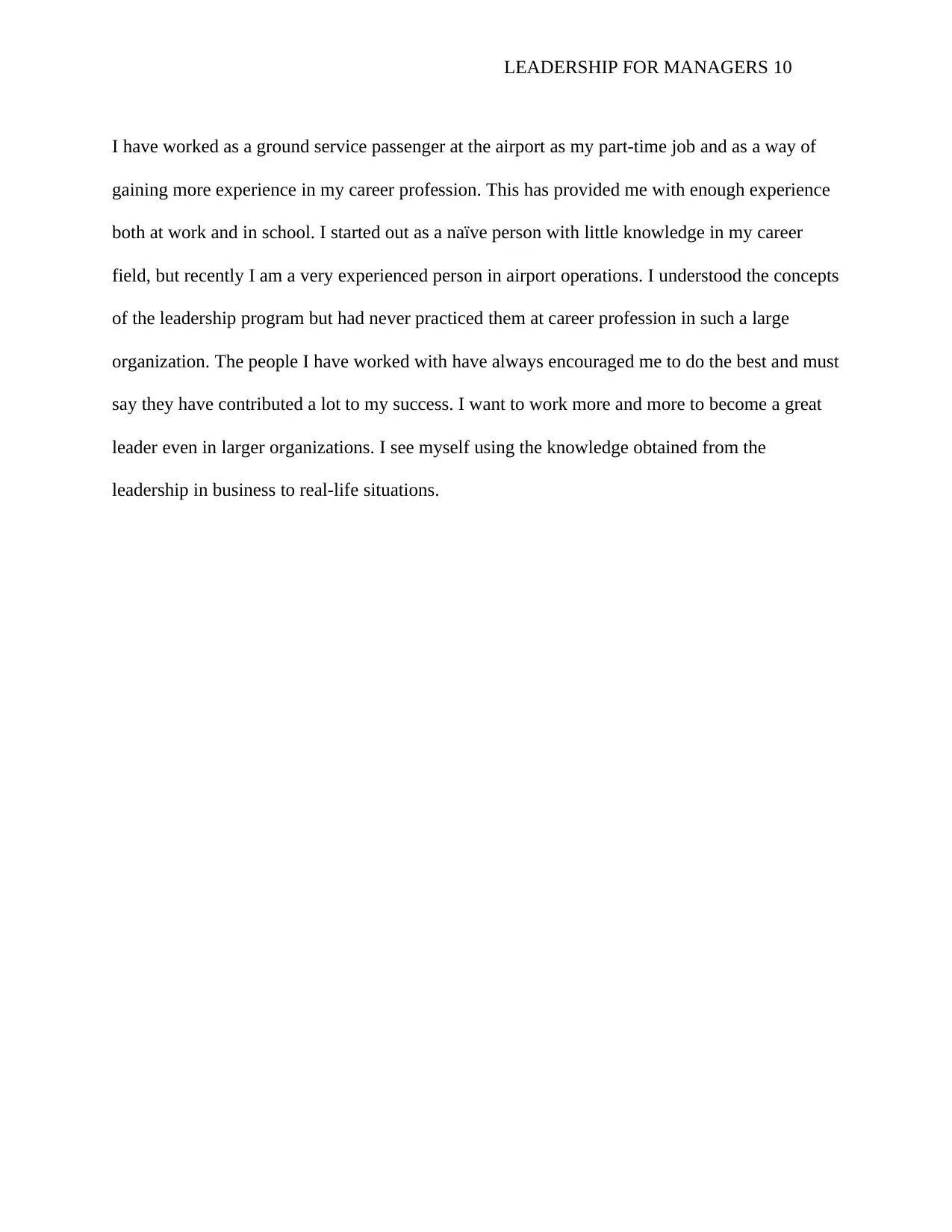
LEADERSHIP FOR MANAGERS 10
I have worked as a ground service passenger at the airport as my part-time job and as a way of
gaining more experience in my career profession. This has provided me with enough experience
both at work and in school. I started out as a naïve person with little knowledge in my career
field, but recently I am a very experienced person in airport operations. I understood the concepts
of the leadership program but had never practiced them at career profession in such a large
organization. The people I have worked with have always encouraged me to do the best and must
say they have contributed a lot to my success. I want to work more and more to become a great
leader even in larger organizations. I see myself using the knowledge obtained from the
leadership in business to real-life situations.
I have worked as a ground service passenger at the airport as my part-time job and as a way of
gaining more experience in my career profession. This has provided me with enough experience
both at work and in school. I started out as a naïve person with little knowledge in my career
field, but recently I am a very experienced person in airport operations. I understood the concepts
of the leadership program but had never practiced them at career profession in such a large
organization. The people I have worked with have always encouraged me to do the best and must
say they have contributed a lot to my success. I want to work more and more to become a great
leader even in larger organizations. I see myself using the knowledge obtained from the
leadership in business to real-life situations.
Secure Best Marks with AI Grader
Need help grading? Try our AI Grader for instant feedback on your assignments.
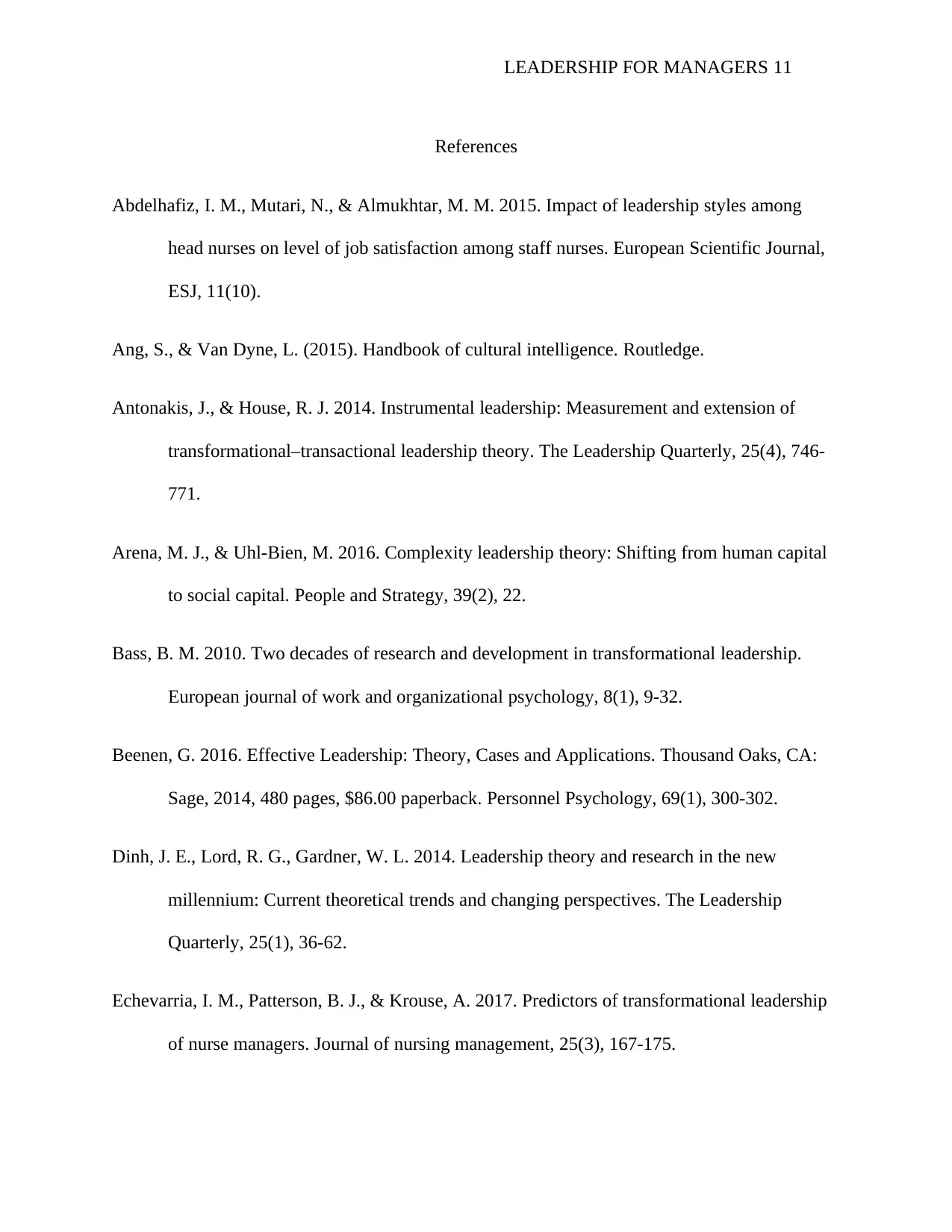
LEADERSHIP FOR MANAGERS 11
References
Abdelhafiz, I. M., Mutari, N., & Almukhtar, M. M. 2015. Impact of leadership styles among
head nurses on level of job satisfaction among staff nurses. European Scientific Journal,
ESJ, 11(10).
Ang, S., & Van Dyne, L. (2015). Handbook of cultural intelligence. Routledge.
Antonakis, J., & House, R. J. 2014. Instrumental leadership: Measurement and extension of
transformational–transactional leadership theory. The Leadership Quarterly, 25(4), 746-
771.
Arena, M. J., & Uhl-Bien, M. 2016. Complexity leadership theory: Shifting from human capital
to social capital. People and Strategy, 39(2), 22.
Bass, B. M. 2010. Two decades of research and development in transformational leadership.
European journal of work and organizational psychology, 8(1), 9-32.
Beenen, G. 2016. Effective Leadership: Theory, Cases and Applications. Thousand Oaks, CA:
Sage, 2014, 480 pages, $86.00 paperback. Personnel Psychology, 69(1), 300-302.
Dinh, J. E., Lord, R. G., Gardner, W. L. 2014. Leadership theory and research in the new
millennium: Current theoretical trends and changing perspectives. The Leadership
Quarterly, 25(1), 36-62.
Echevarria, I. M., Patterson, B. J., & Krouse, A. 2017. Predictors of transformational leadership
of nurse managers. Journal of nursing management, 25(3), 167-175.
References
Abdelhafiz, I. M., Mutari, N., & Almukhtar, M. M. 2015. Impact of leadership styles among
head nurses on level of job satisfaction among staff nurses. European Scientific Journal,
ESJ, 11(10).
Ang, S., & Van Dyne, L. (2015). Handbook of cultural intelligence. Routledge.
Antonakis, J., & House, R. J. 2014. Instrumental leadership: Measurement and extension of
transformational–transactional leadership theory. The Leadership Quarterly, 25(4), 746-
771.
Arena, M. J., & Uhl-Bien, M. 2016. Complexity leadership theory: Shifting from human capital
to social capital. People and Strategy, 39(2), 22.
Bass, B. M. 2010. Two decades of research and development in transformational leadership.
European journal of work and organizational psychology, 8(1), 9-32.
Beenen, G. 2016. Effective Leadership: Theory, Cases and Applications. Thousand Oaks, CA:
Sage, 2014, 480 pages, $86.00 paperback. Personnel Psychology, 69(1), 300-302.
Dinh, J. E., Lord, R. G., Gardner, W. L. 2014. Leadership theory and research in the new
millennium: Current theoretical trends and changing perspectives. The Leadership
Quarterly, 25(1), 36-62.
Echevarria, I. M., Patterson, B. J., & Krouse, A. 2017. Predictors of transformational leadership
of nurse managers. Journal of nursing management, 25(3), 167-175.
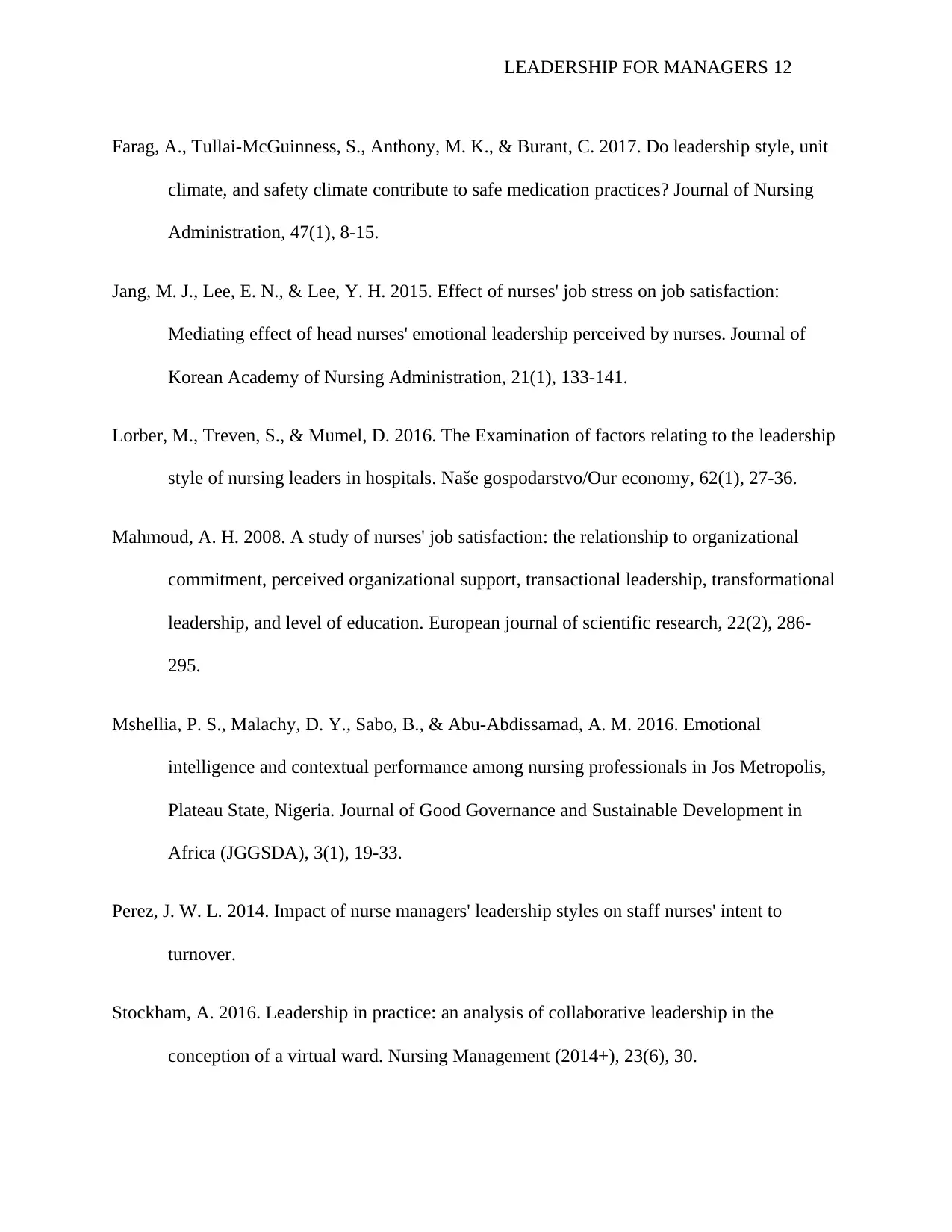
LEADERSHIP FOR MANAGERS 12
Farag, A., Tullai-McGuinness, S., Anthony, M. K., & Burant, C. 2017. Do leadership style, unit
climate, and safety climate contribute to safe medication practices? Journal of Nursing
Administration, 47(1), 8-15.
Jang, M. J., Lee, E. N., & Lee, Y. H. 2015. Effect of nurses' job stress on job satisfaction:
Mediating effect of head nurses' emotional leadership perceived by nurses. Journal of
Korean Academy of Nursing Administration, 21(1), 133-141.
Lorber, M., Treven, S., & Mumel, D. 2016. The Examination of factors relating to the leadership
style of nursing leaders in hospitals. Naše gospodarstvo/Our economy, 62(1), 27-36.
Mahmoud, A. H. 2008. A study of nurses' job satisfaction: the relationship to organizational
commitment, perceived organizational support, transactional leadership, transformational
leadership, and level of education. European journal of scientific research, 22(2), 286-
295.
Mshellia, P. S., Malachy, D. Y., Sabo, B., & Abu-Abdissamad, A. M. 2016. Emotional
intelligence and contextual performance among nursing professionals in Jos Metropolis,
Plateau State, Nigeria. Journal of Good Governance and Sustainable Development in
Africa (JGGSDA), 3(1), 19-33.
Perez, J. W. L. 2014. Impact of nurse managers' leadership styles on staff nurses' intent to
turnover.
Stockham, A. 2016. Leadership in practice: an analysis of collaborative leadership in the
conception of a virtual ward. Nursing Management (2014+), 23(6), 30.
Farag, A., Tullai-McGuinness, S., Anthony, M. K., & Burant, C. 2017. Do leadership style, unit
climate, and safety climate contribute to safe medication practices? Journal of Nursing
Administration, 47(1), 8-15.
Jang, M. J., Lee, E. N., & Lee, Y. H. 2015. Effect of nurses' job stress on job satisfaction:
Mediating effect of head nurses' emotional leadership perceived by nurses. Journal of
Korean Academy of Nursing Administration, 21(1), 133-141.
Lorber, M., Treven, S., & Mumel, D. 2016. The Examination of factors relating to the leadership
style of nursing leaders in hospitals. Naše gospodarstvo/Our economy, 62(1), 27-36.
Mahmoud, A. H. 2008. A study of nurses' job satisfaction: the relationship to organizational
commitment, perceived organizational support, transactional leadership, transformational
leadership, and level of education. European journal of scientific research, 22(2), 286-
295.
Mshellia, P. S., Malachy, D. Y., Sabo, B., & Abu-Abdissamad, A. M. 2016. Emotional
intelligence and contextual performance among nursing professionals in Jos Metropolis,
Plateau State, Nigeria. Journal of Good Governance and Sustainable Development in
Africa (JGGSDA), 3(1), 19-33.
Perez, J. W. L. 2014. Impact of nurse managers' leadership styles on staff nurses' intent to
turnover.
Stockham, A. 2016. Leadership in practice: an analysis of collaborative leadership in the
conception of a virtual ward. Nursing Management (2014+), 23(6), 30.
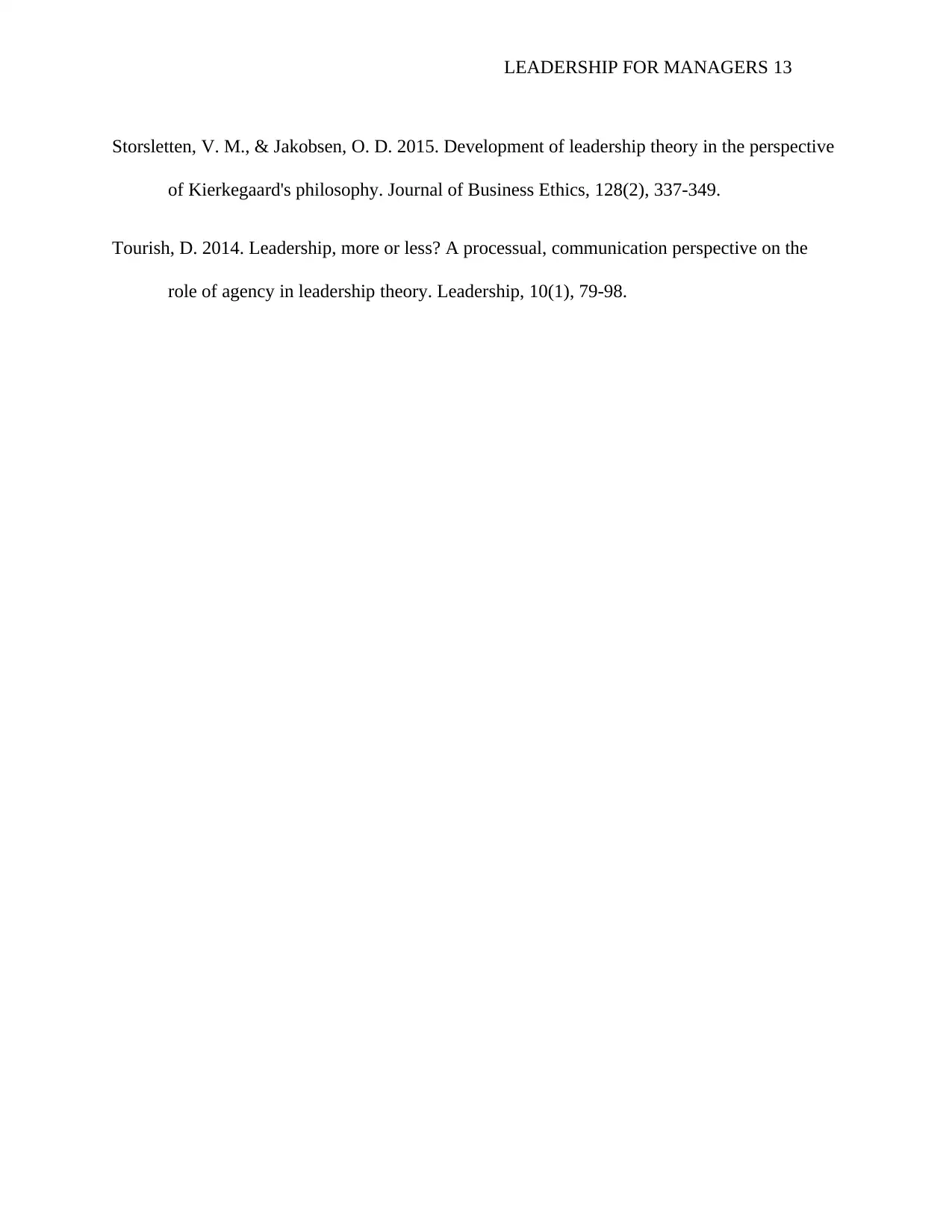
LEADERSHIP FOR MANAGERS 13
Storsletten, V. M., & Jakobsen, O. D. 2015. Development of leadership theory in the perspective
of Kierkegaard's philosophy. Journal of Business Ethics, 128(2), 337-349.
Tourish, D. 2014. Leadership, more or less? A processual, communication perspective on the
role of agency in leadership theory. Leadership, 10(1), 79-98.
Storsletten, V. M., & Jakobsen, O. D. 2015. Development of leadership theory in the perspective
of Kierkegaard's philosophy. Journal of Business Ethics, 128(2), 337-349.
Tourish, D. 2014. Leadership, more or less? A processual, communication perspective on the
role of agency in leadership theory. Leadership, 10(1), 79-98.
1 out of 13
Related Documents
Your All-in-One AI-Powered Toolkit for Academic Success.
+13062052269
info@desklib.com
Available 24*7 on WhatsApp / Email
![[object Object]](/_next/static/media/star-bottom.7253800d.svg)
Unlock your academic potential
© 2024 | Zucol Services PVT LTD | All rights reserved.





